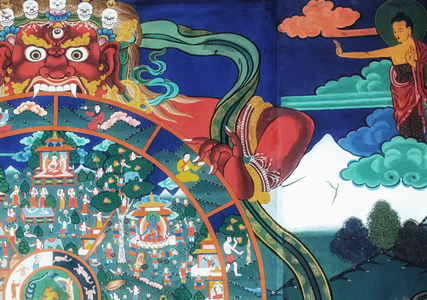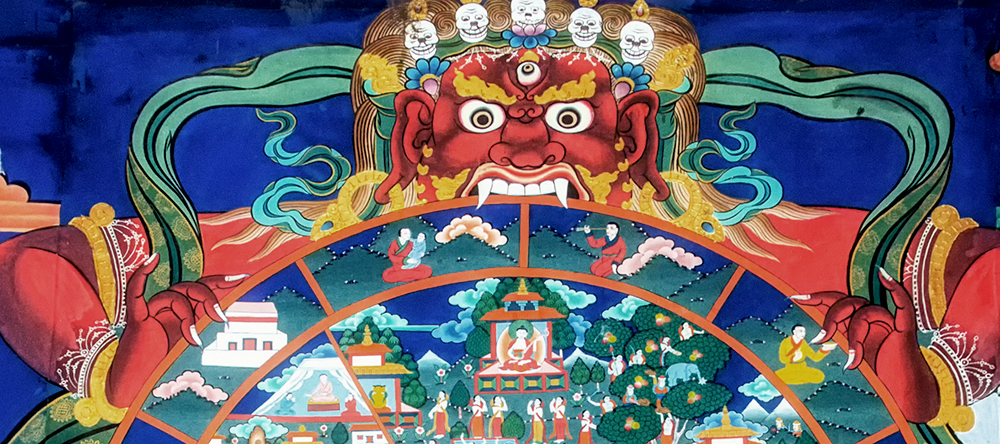Skilful Restraint
The Wheel of life gives us a powerful tool for understanding the source of attachment and rebirth. By skilfully pairing this knowledge with the power of restraint we can begin to enter into Nirvana.

Ancient wall painting in the Rinpung Dzong, Bhutan
Shutterstock
Restraint, discipline (Sanskrit; Sila) is the second Paramita.
The Buddha took a Hindu symbol, the Wheel of Life, and re-explained it in different terms. Briefly, there are in essence three concentric circles. In the centre there are the three passions of greed, hatred and delusion.

The next circle contains the six realms. These are the psychological (and physical) states we are reborn into and through which we transmigrate from moment to moment, hour by hour or day by day. These states are shown on the wheel as the heavenly realms of the gods at the top and the hell realms at the bottom, and then at the sides the angry demons, the animals, the hungry ghosts and the human state.

Outside this wheel, we have the wheel of the twelve-linked chain of arising due to conditions, which details the sequence of events by which we transmigrate through the six realms. On the very outside, we have a terrifying looking demon, Yama, the God of impermanence, who is holding the wheel. This demon has five skulls on its head. Each skull represents the five aggregates – the psycho-physical factors which constitute a human being, - all of which are impermanent. The demon is holding the entire Wheel of Life in its claws and appears to be devouring it. Impermanence does just that; it devours all compounded things.

The passions at the centre; greed, hatred and delusion, are the powerhouse that drives this transformation from state to state. Unless there is development of restraint, we are condemned to continue transmigrating through the six different realms, some of which can be pleasant but most which involve quite a bit of suffering. The Zen text known as ‘The Ten Bull Herding Pictures’ goes into great detail in showing the steps through which the powerful energy of the passions can be transformed and how vitally important this is.
It goes like this: at first there is a realization that something is not quite right, that something is missing but we are not sure what this is. There is then a discovery of a very great energy, which is described as a Bull, which is functioning unchecked, driving karmic actions and keeping us on the wheel. This energy is the passions. Our practice is to develop an awareness of these passions and their arising and to hold them using the body. This is where restraint comes in. It is not a repression of the energy but a holding, a containing, and in so doing the Bull is eventually gentled. The gentling is a transformation of that energy from greed, hatred and delusion into wisdom and compassion.
I had to go to work unusually early one day. I stepped out of the tube station and started to walk down the street. The street was completely empty of people and cars. It was a grey windy morning. I saw the wind pick up an abandoned newspaper that was lying on the pavement and blow it across the road. A few moments later it blew it back again further down. As I walked, this newspaper was blown back and forth across the road. It then struck me that this was just like the passions that were blowing me back and forth. Being unaware of what was happening, I was just suffering the consequences much like the paper. We cannot escape circumstance, but whether we are blown about by it or have the awareness to recognize it and practice restraint and respond accordingly and appropriately are two very different situations.
To help guide us there are the precepts. These are to abstain from killing, theft, sexual misconduct, lying and intoxication. Some are more of a challenge than others. Some can be very subtle - for example: sometimes we fall into that grey area of a partial truth that slips out inadvertently in speech – truth that isn’t quite true so that we can divert some blame away from ourselves or take a little more credit than is due. We will fail many times, but by giving ourselves into the practice the strength and awareness grow, as does our ability not to be deceived by our reactions to what is perceived by the senses. This is a gradual process.
There is a Jewish story that dates from around the first century BC. It concerns a ‘heathen’ who was interested in the Jewish teaching, the Torah. He went to a well-known Rabbi, Rabbi Shammai, and said to him, “ I wish to convert, but on the condition you can teach me the whole of the Torah while I am standing on one foot”. Rabbi Shammai drove him away. The heathen then went up to Rabbi Hillel and asked the same question. Rabbi Hillel replied “That which is hateful to you, do not do to your neighbour. This is the whole teaching; the rest is commentary – go and learn it”. Rabbi Hillel does not advise him to do good but rather to refrain from doing that which is he knows is not good. The good that is done is by restraint, by not doing. This reduces the danger of the heroic riding out to do good. His response also points to the inherent wisdom that he recognizes is in all human beings; this was a heathen, yet he said to him to look at the things within himself that he recognized were not helpful.
As the Buddha said, “All beings have the wisdom and strength of the Tathagata but because of sticky attachments do not know it”. Through the practice of restraint, these sticky attachments weaken and as they do so we become aware of another aspect which is to do with compassion or consideration of others. Restraint allows for the flowering of compassion, it creates room for it, conditions for it. By restraining ‘myself’, a space is created, a space in which others can be considered.




